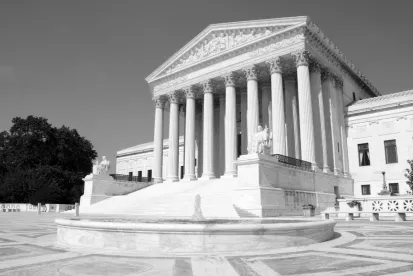Greetings, Court Fans!
Three new decisions this week, each unanimous. First, in United States v. Palomar-Santiago (No. 20-437), the Court held that defendants charged with unlawfully reentering the United States following an order of removal can collaterally attack the validity of the prior removal order only when three statutory prerequisites are met, rejecting the Ninth Circuit’s rule that these requirements could be excused in certain cases. Second, in Guam v. United States (No. 20-382), the Court addressed when a settlement of environmental liabilities gives rise to a contribution action under CERCLA, thereby reviving Guam’s suit against the U.S. Navy for environmental contamination. Finally, in San Antonio v. Hotels.com (No. 20-334), the Court held that Rule 39 of the Federal Rules of Appellate Procedure does not permit a district court to alter a court of appeals’ allocation of appellate costs.
Let’s start with the intersection of criminal and immigration law in United States v. Palomar-Santiago (No. 20-437). Refugio Palomar-Santiago is a Mexican national who obtained lawful permanent resident status in 1990. A few years later, he was convicted of a felony DUI. At the time, a DUI was considered an aggravated felony, which triggered his removal from the United States pursuant to 8 U.S.C. § 1227. But six years after Palomar-Santiago’s conviction, the Court decided in Leocal v. Ashcroft that DUI offenses lack the requisite mens rea to qualify as aggravated felonies. This meant that Palomar-Santiago’s removal order never should have been issued because he did not commit an aggravated felony.
Fast forward to 2017 when Palomar-Santiago was found living in the United States. He was soon charged with unlawfully reentering the United States following a removal order, in violation of 8 U.S.C. § 1326(a). He moved to dismiss the indictment, arguing that that his prior removal order was invalid in light of Leocal. But Section 1326(d) provides that defendants charged with criminal reentry “may not challenge the validity of the deportation order . . . unless” they show that they (1) exhausted any administrative remedies to challenge the order, (2) that the deportation proceeding at which the order was issued improperly deprived them of the chance for judicial review, and (3) that the order was fundamentally unfair. Consistent with Ninth Circuit precedent, the district court held that Palomar-Santiago did not need to satisfy the first two requirements, because his offense (the DUI) did not actually make him removable. The Court granted certiorari to resolve a circuit split over whether the first two requirements of Section 1326(d) apply to defendants removed based on non-removable offenses.
Writing for a unanimous Court, Justice Sotomayor quickly concluded they are not. Beginning with the statute’s text, it provides that defendants charged with unlawful reentry “may not”challenge their underlying removal orders “unless”they satisfy all three requirements enumerated by the statute. When Congress uses mandatory language requiring administrative exhaustion like this, courts are simply not free to excuse a party’s failure to exhaust. Since that is just what the Ninth Circuit’s interpretation of the statute did, it could not be squared with the statute’s plain text. Justice Sotomayor rejected Palomar-Santiago’s counterarguments. First, he argued that administrative review is not “available” when a judge erroneously informs a noncitizen that his prior conviction renders him removable because a noncitizen might not recognize the judge’s substantive error (and thus know to seek review). But that gets things backwards; the whole purpose of administrative exhaustion (and judicial review) is to fix legal errors like that made by the judge in Palomar-Santiago’s underlying removal case. Next, Palomar-Santiago asserted that Section 1326(d)’s requirements only apply to procedural and not substantive attacks on removal orders because substantively flawed orders are invalid from the outset. But Section 1326(d)’s talks of “challenging” or “collaterally attacking” prior removal orders, which plainly encompassed substantive challenges to them. Finally, Palomar-Santiago invoked the canon of constitutional avoidance. But Justice Sotomayor responded that this canon applies only where a statute is ambiguous, which is not the case here. Thus the three requirements of Section 1326(d) are mandatory.
Our second case of the week, Guam v. United States (No. 20-382), asked the Court to define when a settlement “resolves liability” so as to trigger an action for contribution under the Comprehensive Environmental Response, Compensation, and Liability Act of 1980 (“CERCLA”). In another short, unanimous decision, the Court held that to trigger contribution claims, the settlement must resolve a CERCLA-specific liability; resolving liability based on violations of other environmental statutes is not enough.
The case flows from a long-running dispute over the Ordot Dump, a “280-foot mountain of trash” in the center of Guam. The U.S. Navy constructed the dump in the 1940s, depositing toxic military waste there for decades. It then left the dump to Guam, which turned it into a public landfill. Years later, the Environmental Protection Agency EPA sued Guam, alleging that it was discharging pollutants into the waters of the United States without a permit, in violation of the Clean Water Act. Guam and the EPA soon settled the case via a consent decree, which required Guam to take various forms of remedial action. In exchange, Guam was assured that its compliance would be “in full settlement and satisfaction of the civil judicial claims of the United States . . . as alleged in the Complaint,” that is, the EPA’s claims under the Clean Water Act. Thirteen years later, Guam sued the federal government to get it to pay its fair share of the cleanup costs. It did so under CERCLA, which, in relevant part, provides two mechanisms for relief. First, a party can bring a cost-recovery action under CERCLA § 107. If successful, this would allow Guam to recover appropriate costs associated with the cleanup from “any person who at the time of disposal of any hazardous substance owned or operated” the Ordot Dump. Second, a party can bring a contribution action under CERCLA § 113(f). Under that provision, a “person who has resolved its liability to the United States . . . for some or all of a response action or for some or all of the costs of such action in [a] settlement may seek contribution from any person who is not [already] party to a [qualifying] settlement.” Guam sued under both theories. But its complaint was soon dismissed. The D.C. Circuit first concluded that its § 107 and § 113(f) theories were mutually exclusive: if Guam had a § 113(f) action, it couldn’t also have a § 107 action. The D.C. Circuit then held that Guam did have a § 113(f) claim based on its 2004 consent decree with the EPA, but that claim was now untimely, as the three-year statute of limitations had long run.
In the Supreme Court, Guam attacked both prongs of the D.C. Circuit’s reasoning. First, retreating from its complaint, it contended that it could never have asserted a § 113(f) action because the 2004 consent decree didn’t specifically resolve liability under CERCLA; rather, it only addressed Guam’s liability under the Clean Water Act. Justice Thomas, joined by everyone, agreed. Section 113(f) begins by providing that any person can seek contribution from any other person who is liable or potentially liable under several other provisions of CERCLA. This focus on CERCLA liability—as well as the title “contribution” given to this type of claim—is the first clue that § 113(f) looks to the distribution of CERCLA liability specifically. Other provisions of § 113(f) point in the same direction. (They’re all a bit technical, so we’ll gloss over the gory details here.) Taken together, then, the most natural reading of § 113(f) is that it allows a party to bring a contribution claim only after the party has settled CERCLA-specific liability. Since Guam had never done that—it only had settled Clean Water Act liability—it never had a § 113(f) claim in the first place. The Court thus remanded to reconsider Guam’s § 107 claim.
Finally, in San Antonio v. Hotels.com (No. 20-334), the Court resolved a circuit split over whether district courts have discretion to deny or reduce the costs awarded by a court of appeals to the prevailing party in an appeal. Federal Rule of Appellate Procedure 39 permits the taxation of appellate “costs” (not including attorneys’ fees) to the prevailing party in an appeal. Under FRAP 39(a)(3), the default rule is that “if a judgment is reversed, costs are taxed against the appellee.” At issue in this case was Rule 39(e), which identifies four categories of “costs on appeal” that “are taxable in the district court for the benefit of the party entitled to costs under this rule.” Since those costs are taxable in the district court, does it follow that district courts have discretion over whether and to what extent to award them? In a unanimous decision authored by Justice Alito, the Supreme Court answered no.
The case arose out of a tax dispute between Texas municipalities and various online travel companies (OTCs), including Hotels.com. Back in 2006, San Antonio filed a class action lawsuit (on behalf of 173 municipalities) alleging that the OTCs had been systematically underpaying hotel occupancy taxes by calculating them using the wholesale rate that the OTCs negotiated with hotels rather than the retail rate that consumers actually paid. After a jury trial, the district court entered a judgment of approximately $55 million in favor of the class. The OTCs sought stay the judgment beyond the usual 30 days by providing a supersedeas bond under FRCP 62(b). After negotiating with San Antonio, the OTCs put up about $69 million to stay the judgment while they pursued various post-verdict motions. Eventually, the OTCs appealed to the Fifth Circuit, and persuaded it that they had not underpaid the hotel occupancy taxes. The OTCs proceeded to file their bill of costs in the circuit court—for about $900 covering the cost of filing fees and printing—without objection. Back in the District Court, thought, they filed a bill of costs for more than $2.3 million. That’s because one of the categories of costs identified in Rule 39(e) is “premiums paid for a bond or other security to preserve rights pending appeal,” and by the time the OTCs prevailed in the Fifth Circuit, they’d paid an awful lot in supersedeas bond premiums. San Antonio cried foul, arguing that the OTCs should have pursued alternatives to a supersedeas bond and that it was unfair for San Antonio to bear the costs for the entire class rather than just its proportionate share. The District Court was sympathetic but held, citing Fifth Circuit precedent, that it lacked discretion regarding whether, when, and to what extent to award costs. The Fifth Circuit affirmed, reiterating its position (not shared by other circuits), that district courts lack discretion to deny or reduce appellate costs.
The Supreme Court affirmed. Writing for the unanimous court, Justice Alito observed that Rule 39 creates a “cohesive scheme” for taxing appellate costs, which gives discretion over allocation only to the courts of appeals. Rule 39(a) sets out default rules based on the outcome of an appeal and provides that these default rules apply unless the appellate court orders otherwise. Where the appellate court has awarded costs, there is no remaining discretion for those costs that are taxable in the district court under Rule 39(e). That provision, after all, refers to “the party entitled to costs,” not the party entitled to seek costs. In this respect, Justice Alito rejected San Antonio’s argument that the language “taxable in the district court” vests district courts with discretion over allocations. That reading, he maintained ignores the history of the Rule, which showed that the point of the phrase “taxable in the district court” is simply to specify in which court these types of costs are to be taxed. Alito also rejected San Antonio’s policy arguments. First, limiting a district court’s discretion to allocate appellate costs would not cause confusion over the equitable discretion district courts do have with respect to costs that are incurred prior to appeal. Second, there is no reason to think that appellate courts can’t adequately allocate appellate costs (including by delegating that task to district courts, as some circuits do). Third, district courts do play a meaningful role in assessing costs under Rule 39(e) in that they confirm that the amount of appellate costs requested is correct. And finally, parties are not unable to obtain review of objections to Rule 39(e) allocations after cases are returned to the district courts. They can, for example, file a “simple motion for an order” under FRAP 27, among other possible avenues. So in the end, while San Antonio is out of luck in this case, the Court was not concerned that other litigants would be unduly prejudiced by its reading of Rule 39.





 />i
/>i

